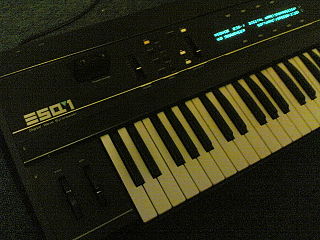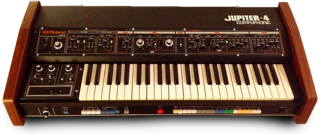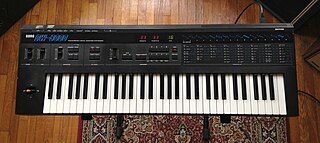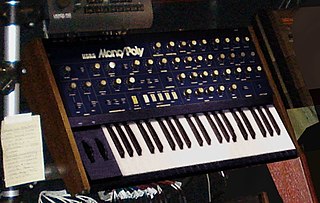

Sometimes referred to as the Murom Aelita, the Aelita is a monophonic analog synthesizer manufactured in the Soviet Union in the 1980s. [1]


Sometimes referred to as the Murom Aelita, the Aelita is a monophonic analog synthesizer manufactured in the Soviet Union in the 1980s. [1]
Manufacturing started in 1980 at the Murom radio plant. [2] The electronics was revised in 1986, but the features remained the same.
Although its design seems inspired from American and Japanese synthesizers of the previous decade, with a dark aluminum body [3] and near vertical control panel, the Aelita's looks are distinctive in the details.
They feature large colored plastic sliders instead of the more common rotary dials, and round or rounded push-buttons instead of flip or rotary switches. The vertical sliders are oriented so that their maximum labelled value is at the bottom, instead of the top as is more common. A sole red LED lights up when the instrument is on.
Its hinge-mounted upper control panel can be shut like a piano keyboard's lid, [4] thus protecting the buttons and sliders and preventing accidental settings changes during transportation, and changing the general shape of the instrument to one that is not playable but more transportable.
The keyboard is 3.5 octaves wide and made of 44 unweighted, full-sized plastic keys ranging from F to C. [2]
All controls are labelled in Russian, using Cyrillic script.
The Aelita has 3 oscillators, each with 3 fixed waveshapes (Saw, Pulse and Square), plus a 4th oscillator only active in unison mode, amplitude cross-modulation, a low-pass filter with resonance, one LFO and two envelope generators, all arranged in a fixed architecture typical of subtractive synthesis. [1] [4] [5] It has a maximum range of 7.5 octaves. [1] It is monophonic, meaning that it can play only one note at a time (although detuning of each oscillator makes it possible to play fixed intervals or chords instead of notes). [2] [3]
It has two special modes: the unison mode creates an unison-like effect on each oscillator (reducing the range as a tradeoff), and the strings mode creates a vibrato-like effect independent of the LFO. [4]
Although of a sturdier construction, it lacks several features commonly found on American and Japanese brand synthesizers at the time, such as : velocity response, portamento, pitch and modulation wheels or levers, settings memory, and (from late 1982 on) MIDI implementation. [3] [6] [7]
Its sonic qualities have been consistently qualified as "fat". [2] [3] [4] [5] [6] Other reviewers also call them "impressive", [3] [5] and sometimes "aggressive". [3] [5] There is audible background noise at the output, resembling oscillator bleed.

Novation Digital Music Systems Ltd. is a British musical equipment manufacturer, founded in 1992 by Ian Jannaway and Mark Thompson as Novation Electronic Music Systems. Today the company specializes in MIDI controllers with and without keyboards, both analog and virtual analog performance synthesizers, grid-based performance controllers, and audio interfaces. At present, Novation products are primarily manufactured in China.

Ensoniq ESQ-1 is a 61-key, velocity sensitive, eight-note polyphonic and multitimbral synthesizer released by Ensoniq in 1985. It was marketed as a "digital wave synthesizer" but was an early Music Workstation. Although its voice generation is typically subtractive in much the same fashion as most analog synthesizers that preceded it, its oscillators are neither voltage nor "digitally controlled", but true digital oscillators, provided by a custom Ensoniq wavetable chip. The signal path includes analog resonant low-pass filters and an analog amplifier.
The Yamaha AN1x is a DSP-based analog modeling synthesizer, produced by Yamaha Corporation from 1997 to 1998, and was marketed as an "analog physical modelling control synthesizer".

The Roland MC-202 (MicroComposer) is a monophonic analog synthesizer and music sequencer released by Roland in 1983. It was the first groovebox. Its synth is similar to the TB-303 bass synth and the SH-101 synthesizer, featuring one voltage-controlled oscillator with simultaneous saw and square/pulse-width waveforms. It is a successor to the Microcomposer family of sequencers, including the MC-8 and MC-4. The unit is portable and can be operated from batteries or an external power supply.

The Realistic Concertmate MG-1 is an analog synthesizer manufactured by Moog Music in 1981 and sold by Radio Shack from 1982 to 1983 under their "Realistic" brand name. It was produced without some standard Moog features, such as pitch and modulation wheels, as a cost-cutting measure aimed at achieving a lower price for the consumer market. The synthesizer also featured a pair of pass-through RCA jacks, which allowed users to mix radio or records into the final live synthesized sound output.

The Roland Jupiter-4 (JP-4) was an analog synthesizer manufactured by the Roland Corporation between 1978 and 1981. It was notable as the company's first self-contained polyphonic synthesizer, and for employing digital control of analog circuits, allowing for such features as programmable memory, voice assignment modes, an arpeggiator, polyphonic portamento and others.

The microKORG is a MIDI-capable digital synthesizer/vocoder from Korg featuring DSP-based analog modelling. The synthesizer is built in such a way that it is essentially a Korg MS-2000 with a programmable step arpeggiator, a less advanced vocoder, lack of motion sequencing, lack of an XLR microphone input, and in a smaller case with fewer real-time control knobs.

The Korg DW-8000 is a polyphonic hybrid digital-analog synthesizer released in 1985. It blends digital waveforms with an analog filter and amplifier, followed by a digital delay for adding echo effects. It boasts eight-note polyphony and its keyboard is equipped with velocity sensitivity and aftertouch.

The Korg Prophecy is a monophonic synthesizer released by Korg in 1995. Korg's first monophonic synthesizer since the Mono/Poly, the Prophecy employs Korg's Multi Oscillator Synthesis System (MOSS), which features digital oscillators capable of emulating synthesis techniques such as analog synthesis, FM and physical modelling. Emphasized for its portability, expressiveness, and engaging playability, a distinctive feature of the Prophecy is its multifunctional Wheel 3, nicknamed the 'log'.
The Memorymoog is a polyphonic electronic music synthesizer manufactured by Moog Music from 1982 to 1985, the last polyphonic synthesizer to be released by Moog Music before the company declared bankruptcy in 1987. While comparable to other polyphonic synthesizers of the time period, such as the Sequential Circuits Prophet-5 and Oberheim OB-Xa, the Memorymoog distinguished itself with an additional, 3rd audio oscillator per voice and greater preset storage capacity.

The Moog Source is a monophonic Z80 microprocessor-controlled analog synthesizer manufactured by Moog Music from 1981 to 1985. The Source was Moog's first synthesizer to offer patch memory storage. The design was also the first Moog synthesizer to feature a flat-panel membrane keyboard to replace the standard buttons, knobs and sliders, along with multihued panel graphics that were very different from anything Moog offered at the time. Sound wise it is considered to sound more like the original Moog Minimoog than any other synthesizer made by Moog and was introduced as its replacement.
The Siel DK70 is a synthesizer produced in 1986 by Siel.

Roland JX-8P is a 61-key, velocity- and aftertouch-sensitive, six-note polyphonic, almost entirely analog synthesizer released by Roland in 1985. In a time of rising popularity of digital frequency modulation synthesizers, such as Yamaha DX7, JX-8P was marketed as the best of both worlds: while it was possible to create classic analog synth sounds, several new modulation parameters and redesigned hardware enabled it to produce certain types of sounds associated with FM synthesis, such as metallic percussive sounds. Likewise, traditional hands-on controls were replaced with a Yamaha DX7-style interface with membrane buttons and one "edit" slider.

The Korg Mono/Poly (MP-4) is a paraphonic analog synthesizer released by Korg in 1981, bridging the gap between monophonic and polyphonic synthesis. Released in the same year as the Korg Polysix, as a complementary synth, The Mono/Poly is equipped with four VCOs and can operate as a four-voice paraphonic synth with limited capabilities, or as a monophonic synth using all four oscillators. Upon its release, it was the only monophonic synthesizer with an integrated quad-VCO design available on the market.

The Split-8 is a polyphonic analogue keyboard synthesizer manufactured by Sequential Circuits. Built in Japan and going by the alternative name Pro-8 in some markets, this was one of the last synthesizers produced by the company and was assigned model number 608. It was released in 1985 at a list price of $1,199. This and some other Sequential Circuits synthesizers were built around the Curtis Electronics CEM 3394 "synth-on-a-chip" integrated circuit, and used a Z80 as their central microprocessor.

The AX80 is a polyphonic analogue keyboard synthesizer manufactured by Akai Professional in 1984. It was Akai's first venture into the professional electronic musical instrument market. The AX80 used digitally controlled oscillators (DCO) and filter circuitry based on the Curtis Electronics CEM 3372 integrated circuit. It was marketed as part of a line of project studio equipment called the Akai Music Studio System, which included the S612 digital sampler the MR16 drum machine, the MS08 sequencer, and the MG1212 multitrack tape recorder, at a price of $1,695 US.

The AX60 is a polyphonic analogue keyboard synthesizer manufactured by Akai Professional in the mid-1980s. It was Akai's answer to the popular Roland Juno series synthesizers. The AX60 uses voltage-controlled analogue oscillators and filter circuitry based on the Curtis Electronics CEM 3394 integrated circuit.

The CZ series is a family of low-cost phase distortion synthesizers produced by Casio in the mid-1980s. Eight models of CZ synthesizers were released: the CZ-101, CZ-230S, CZ-1000, CZ-2000S, CZ-2600S, CZ-3000, CZ-5000, and the CZ-1. Additionally, the home-keyboard model CT-6500 used 48 phase distortion presets from the CZ line. The CZ synthesizers' price at the time of their introduction made programmable synthesizers affordable enough to be purchased by garage bands. Yamaha soon introduced their own low-cost digital synthesizers, including the DX-21 (1985) and Yamaha DX100, in light of the CZ series' success.

The Arturia MiniBrute is a synthesizer manufactured by Arturia. Although the MiniBrute was the first piece of analog hardware created by Arturia—which had previously exclusively marketed software synthesizers—it generated strong sales.

The Volca Keys is a analogue synthesizer manufactured by the Japanese music technology company Korg. It was announced in April 2013 at MusikMesse and was at the time one of the few affordable analogue synthesizers available. The Volca Keys uses subtractive synthesis to create sounds and is three-note paraphonic, meaning that it can play chords with all voices sharing a single voltage-controlled filter (VCF).